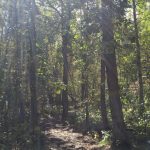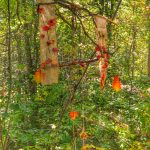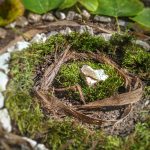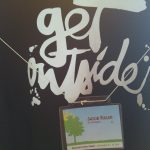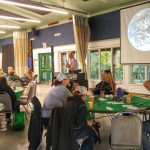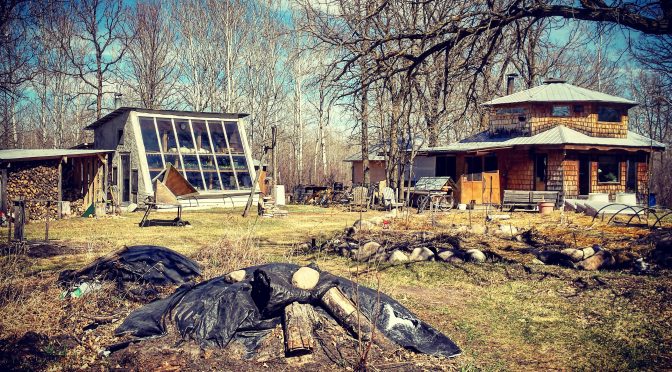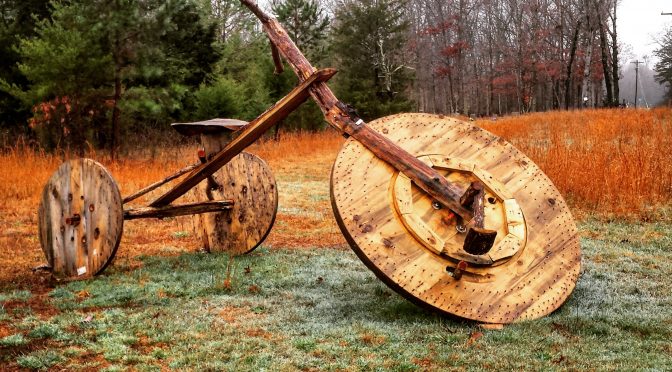 After returning home from our first visit to Whole Village in September of 2017(link), our interest was piqued. There were many things about this community that we liked and met our own checklist. We liked the organizational structure, the farm, the people and their vision. The vibe was great. The community had mature roots and was capable of weathering storms. Julia felt great in their space, and Arthur and I did too.
After returning home from our first visit to Whole Village in September of 2017(link), our interest was piqued. There were many things about this community that we liked and met our own checklist. We liked the organizational structure, the farm, the people and their vision. The vibe was great. The community had mature roots and was capable of weathering storms. Julia felt great in their space, and Arthur and I did too.
 We upped our interest level and committed to a two week visit. In April, 2018 we flew out to Hamilton, Ontario, rented a car and stayed in a suite in the spectacular Greenhaven. What a great trip! The community was hospitable, open and accommodating. Staying for two weeks was a great way to experience life at the community. It gave us an intense, live-in experience of what it would be like.
We upped our interest level and committed to a two week visit. In April, 2018 we flew out to Hamilton, Ontario, rented a car and stayed in a suite in the spectacular Greenhaven. What a great trip! The community was hospitable, open and accommodating. Staying for two weeks was a great way to experience life at the community. It gave us an intense, live-in experience of what it would be like.
 The two weeks gave us an idea of what the routines in the community are like. That sort of thing is hard to figure out if one is coming for a work bee or a day or two here and there. Mondays are check ins, community meals are two to three times a week, whenever someone signs up to cook. Farm routines vary and take a little getting used to.
The two weeks gave us an idea of what the routines in the community are like. That sort of thing is hard to figure out if one is coming for a work bee or a day or two here and there. Mondays are check ins, community meals are two to three times a week, whenever someone signs up to cook. Farm routines vary and take a little getting used to.
Being there for two weeks also gave the community a better sense of who we are. It showed the community what our baseline attitudes are and how our family interacts together. Think of it as the ‘seeing each other’ phase in getting to know a potential partner. In my reading, this is an important part of the exploration phase.
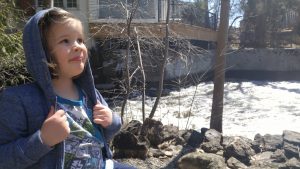 It also was a two-week vacation for the family. We visited Alton Mills, an old mill converted into an art space which is barely ten minutes away. In the opposite direction, Orangeville had everything we would need. The Orangeville culture is very artsy, open and chill. I think of it as a blend between Kenora, ON and two communities in Virginia, Gordonsville and Harrisonburg. It feels like cottage country. At about 31,000 people, Orangeville is a nice size. (Just a little more than half the size of Brandon, MB.)
It also was a two-week vacation for the family. We visited Alton Mills, an old mill converted into an art space which is barely ten minutes away. In the opposite direction, Orangeville had everything we would need. The Orangeville culture is very artsy, open and chill. I think of it as a blend between Kenora, ON and two communities in Virginia, Gordonsville and Harrisonburg. It feels like cottage country. At about 31,000 people, Orangeville is a nice size. (Just a little more than half the size of Brandon, MB.)
The very first morning on the farm Arthur discovered something he would enjoy doing every day. His exuberance collecting chicken eggs made us wonder if he wasn’t born to be a country boy.
 The farm is something that the entire family can really appreciate. Both Julia and I grew up in rural settings, and we really want Arthur to experience a rural life in early childhood. We want him to grow up around animals, getting dirty and playing outside. This environment is important to us. This said, we are also keen to keep him socialized. The studies and pediatric recommendations show that our wants align with their conclusions. The structure of an ecovillage fits this brilliantly.
The farm is something that the entire family can really appreciate. Both Julia and I grew up in rural settings, and we really want Arthur to experience a rural life in early childhood. We want him to grow up around animals, getting dirty and playing outside. This environment is important to us. This said, we are also keen to keep him socialized. The studies and pediatric recommendations show that our wants align with their conclusions. The structure of an ecovillage fits this brilliantly.
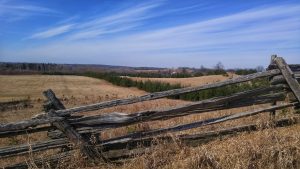 As well, neither of us want to run a farm on our own. It’s a lot of work, and we know it is way too much for only two people. Doing it together with others makes more sense. Once again, an ecovillage fits this.
As well, neither of us want to run a farm on our own. It’s a lot of work, and we know it is way too much for only two people. Doing it together with others makes more sense. Once again, an ecovillage fits this.
Having other kids to play with was something the family enjoyed too. Arthur had a good time with the children. Julia and I got more time together. I found it also had an effect where we appreciated our family time more. There’s a lot of win-win with this situation.
Arthur also enjoyed playing in the rec room between Greenhaven suites. A trunk filled with costumes was an exciting discovery. At one point I pretended to be a dragon that Arthur and the other kids were trying to train. They learned it isn’t easy to train dragons, and that calming influences are better than whacking with swords.
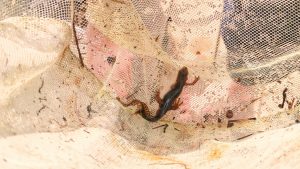 The pond was a great draw for Arthur too. All sorts of aquatic creatures were there, from frogs to fish, bugs and salamanders. This environment to play in was great to see him enjoying.
The pond was a great draw for Arthur too. All sorts of aquatic creatures were there, from frogs to fish, bugs and salamanders. This environment to play in was great to see him enjoying.
Arthur also took to the people in the community very well. He was polite and remembered people’s names better than myself. We received many comments on how good-natured he is.
The established community environment has calming effect for Julia and me. Like most ecovillages, Whole Village is a group of people actively working together in community, doing their best to communicate and get along. When conflict and challenges arise, like they inevitably do with human community, there is the desire to work it out. Non-violent communication is one tool in their toolbox.
 This attitude and orientation to mutual relationships is like a beacon. I grew up in a family where there was no displayed conflict between the adults, and these memories of quietude magnetize the values from early childhood into my later life. High conflict doesn’t move our family forwards. Both Julia and I are weary of the inundation of the dog-eat-dog message both served by the media and exampled in mainstream culture. It is only that, a message that we both feel doesn’t serve us or our family.
This attitude and orientation to mutual relationships is like a beacon. I grew up in a family where there was no displayed conflict between the adults, and these memories of quietude magnetize the values from early childhood into my later life. High conflict doesn’t move our family forwards. Both Julia and I are weary of the inundation of the dog-eat-dog message both served by the media and exampled in mainstream culture. It is only that, a message that we both feel doesn’t serve us or our family.
We want a low to no-conflict environment, and that is difficult to maintain in mainstream culture. The conflicting messages and values in the cultural melting pot does not make it easy to raise kind kids or encourage them to stay authentic.
The message we want to communicate through our choices and example through our life is one of cooperation and harmony. Ecovillages afford us that. That is a component of why we have been on this journey.
 We found it deeply therapeutic to be practicing a lifestyle with others in a neighborhood who are similarly committed to living in harmony with the earth. To be living in right relationship with the planet takes a surprisingly large amount of weight off the shoulders we didn’t know was there.
We found it deeply therapeutic to be practicing a lifestyle with others in a neighborhood who are similarly committed to living in harmony with the earth. To be living in right relationship with the planet takes a surprisingly large amount of weight off the shoulders we didn’t know was there.
There is only so much that can be accomplished as a family living in a city. The degree of garbage is overwhelming and heartbreaking. The pollution, awful.
The difference I feel going from my day job where I am always around a high degree of debris and garbage to a well-cared for piece of land is profound. It particularly bothers me seeing garbage get pushed under the ground through earthworks and landscaping at the jobsites I visit. Being in an ecovillage setting where the landscape is tended to, kept clean and receives a lot of intention creates an ease that is particularly distressing when I return to the job. This garbage creates stress that I notice more and more. It’s human laziness symbolically expressed in the environment. Unfortunately, it’s not something one person can change.
The people of Whole Village were warm and welcoming. We were the outsiders, but they opened their home to our family, treated us well and let Arthur play with their pets. We made new friends, ate meals together and felt accepted.
Journeying to different ecovillages and seeing how others live is a great way of exploring the self as well. It helped us to figure out what is comfortable to us. What works and what doesn’t. And at the end of our visit, we felt that Whole Village worked for us.
We took a few more steps in the Whole Village membership process. They had two different interviews, that we sat in for. It was intense, I got a little nervous, but it came out well. They talked for a while after we left, and then came back to us asking for character references, which was a positive sign. It is now up to the community to determine if we work for them.
Until next time!
The Bullers
More photos on ecovillages.ca.



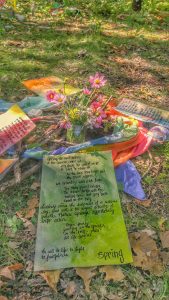

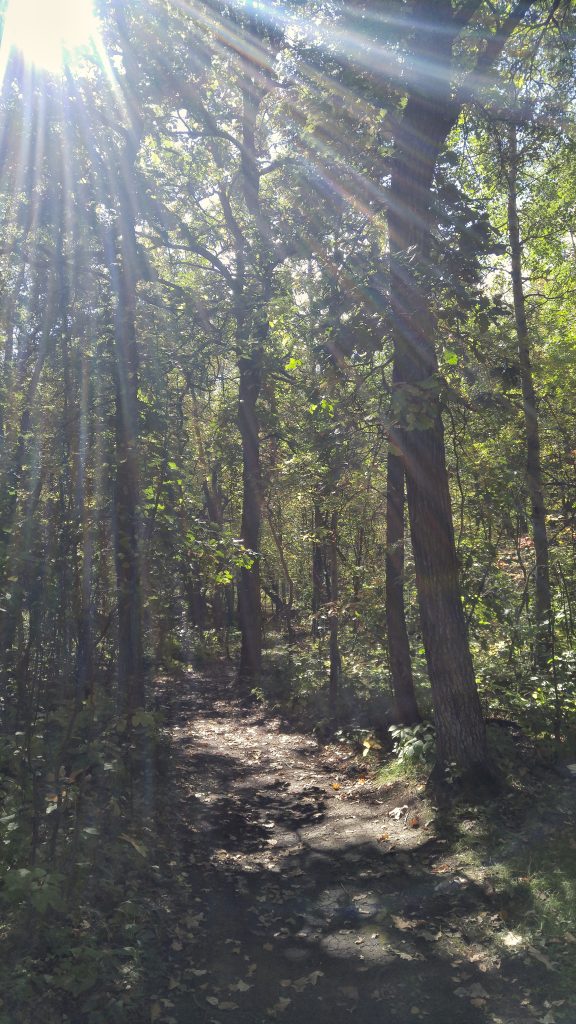 I stayed for the day, and found myself greatly enjoying the event. It gave me a welcoming feeling of being in the right place at the right time. People were focused on something that I feel is very important; children and their interaction with nature. To me, this is a big part of the collective healing process our North American culture needs. It was revitalizing to have a direct participation in that process. I came away from it having matured in my presentation abilities, less naïve but even more hopeful. I discovered that I really like talking about the positive developments that are taking place in this world. There is so much good if we just look for it.
I stayed for the day, and found myself greatly enjoying the event. It gave me a welcoming feeling of being in the right place at the right time. People were focused on something that I feel is very important; children and their interaction with nature. To me, this is a big part of the collective healing process our North American culture needs. It was revitalizing to have a direct participation in that process. I came away from it having matured in my presentation abilities, less naïve but even more hopeful. I discovered that I really like talking about the positive developments that are taking place in this world. There is so much good if we just look for it.